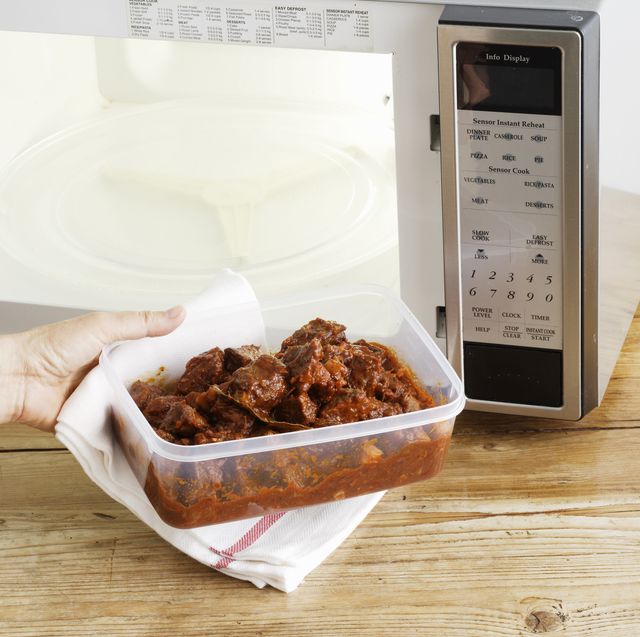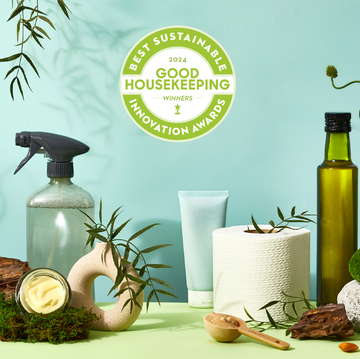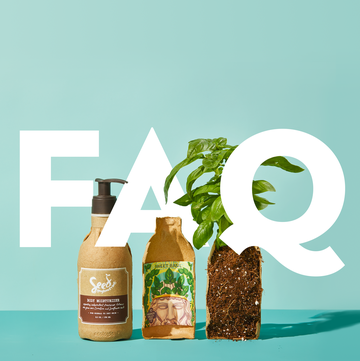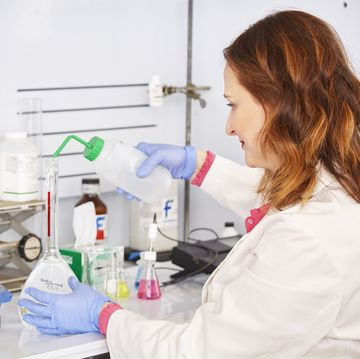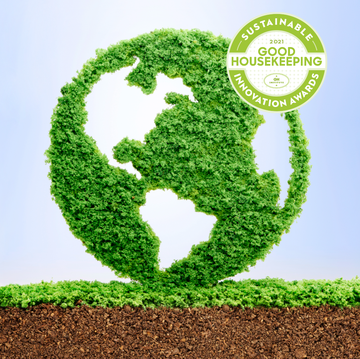My kitchen is probably similar to yours — filled with products that help me get dinner on the table fast. I have cans of beans and tomato paste on my pantry shelves. In the fridge, there's usually a collection of leftovers — last night's lasagna, some barbecued chicken the kids didn't finish — in dishes covered with plastic wrap, ready to eat after a zap in the microwave. I sometimes buy food and drinks in plastic containers, I've been known to chop on a plastic cutting board, and I carry water around in a plastic bottle. So I've grown increasingly alarmed over news stories on plastics in recent months. First, reports quoted scientists and environmental groups saying that the same containers and wraps that have made life so convenient may contain chemicals that can pose dangers to health: bisphenol A (BPA), which, among its many roles, is used to make a type of hard plastic, and certain phthalates (pronounced THAL-ates), a wide range of chemicals that, among their many uses, soften plastic.
Quickly, as the media coverage intensified, manufacturers and retailers took up the charge: Last spring, just when I was packing my kids' lunches with Nalgene water bottles, the company announced it was phasing out bottles made with BPA. Many retailers have decided to stop selling toys and other kids' products with BPA and phthalates, and a growing list of companies, including P&G and Nike, have been taking phthalates out of everything from beauty products to sneakers.
Lawmakers have jumped into action, too. California, Washington State, and Vermont, for example, have limited the allowable amount of phthalates in children's products, and Congress added a partial phthalate ban to its new consumer-protection law, passed in August. But while legislators have been scurrying to pass protective laws, the federal agencies entrusted with overseeing our health have been slow to respond — and maddeningly vague when they do.
In 2007, an expert panel was commissioned by the National Toxicology Program at the National Institute of Environmental Health Sciences, which evaluates chemicals for safety. The panel issued the reassuring statement that it had "minimal concern" about most human health effects from BPA, though it acknowledged "some concern for neural and behavioral effects in fetuses, infants, and children at current human exposure." But after it was reported that a consulting group used by the panel had ties to the industry, NTP scientists revised these findings, raising the level of concern.
It's enough to make a mom toss up her hands — and toss out all the plastic in the house.
Or maybe just in the kitchen? The biggest worry has been over BPA and phthalates getting into food and drinks (and into toys small children chew on). Most of us aren't eager to sacrifice the ease and cleanliness of plastic. But we need more definitive answers than the authorities have been giving us. That's why the Good Housekeeping Institute undertook testing of widely available storage containers, bags, wraps, frozen-entrée trays and slow-cooker liners to see if these chemicals were, in fact, migrating into food — a kind of real-world investigation that would help moms decide just how cautious they need to be.
If the chemicals are getting into food, we need to understand what that means for our health. And if they're not, we'd like to stop hyperventilating. The GHRI tests turned up good news. But a review of additional recent research yielded other unsettling questions, particularly about hormonally related ills. Both the tests and the research point to the smartest ways to keep our families safe.
Where Chemicals Lurk
Many hadn't heard of bisphenol A before it grabbed the headlines earlier this year, but the chemical has been in our lives for decades. Not only is it used to make hard-plastic food containers and baby bottles, but it's also found in eyeglass lenses, compact discs, electronics, and a slew of other common, everyday items. Used in the plastic-like coating that lines food and beverage cans, BPA helps buffer the contents from cans' corrosive metals and extends the products' shelf lives. And when these containers and cans and bottles and CD cases end up in landfills, BPA can leach into rivers and streams, possibly reentering our homes — and bodies — through tap water. The chemical has also been found in household dust, where it settles as plastic products break down and scatter microscopic particles. We all touch it and breathe it in; crawling babies, who put everything in their mouths, may absorb even more.
But our highest exposure comes from our daily diet, reports the National Toxicology Program. Molecules of BPA can migrate from containers into food, especially, say experts, when the containers are heated and the foods are acidic (like tomatoes) or fatty (like gravy). That's why GH Institute used those two food types for its tests — plus, these items are commonly heated in a microwave. Just as a mom might prepare her family's dinner in her kitchen, GHRI scientists, working with chemists at an independent lab, heated samples of Old World Style Ragú Traditional Smooth Pasta Sauce and Heinz Home Style Gravy Savory Beef in the microwave in two different widely available storage containers and in glass bowls covered with a commonly used plastic wrap.
Why these? In pretesting, low levels of BPA had turned up in the two containers — Rubbermaid Easy Find Lids and Rubbermaid Premier. One plastic wrap, Glad Press 'n Seal, had tested positive for low levels of both phthalates and BPA. (A fourth item, Glad Storage Gallon Zipper Bags, was found to contain low levels of BPA, but was eliminated from food testing since it's unlikely that anyone would use the bags for heating liquid foods like pasta sauce or gravy.)
The results: When food was heated in these containers in the microwave (or, in the case of Press 'n Seal, in a glass bowl covered with the wrap prior to microwaving), all three suspect products passed: "No detectable amounts" (to use the scientific phrase) of BPA or phthalates wound up in either the tomato sauce or the gravy.
While this is terrific news, there's more you should understand. For one thing, we know we have these chemicals in our bodies, and they're getting there somehow. Indeed, nearly every American has BPA coursing through his or her veins, according to data gathered in 2003-04 by the Centers for Disease Control and Prevention — and children have the highest levels of all. The FDA estimates that adult Americans consume, on average, a cumulative 11 micrograms of BPA per day through diet — mostly from the liners in canned foods, say several scientific groups. Is that level a lot? Is it safe? No one really knows yet, but "we're concerned about how much exposure there is to this chemical and possible health repercussions," says Anila Jacob, M.D., a physician and senior scientist for the Environmental Working Group (EWG), a nonprofit watchdog scientific organization.
Nor does anyone know for sure whether BPA accumulates in humans over time, though most scientists believe adults process it quickly — in as little as a day. However, the fact that so many of us have the compound in our bodies means that we're exposed to it daily, says Dr. Jacob. And fetuses and babies may not metabolize the chemical as well as adults, other experts point out, so it's possible that it builds up in their small bodies.
Just Can These
The insides of food cans are often lined with an epoxy resin that keeps corroding metal away from the food. But bisphenol A in that resin can migrate into the foods; in fact, it's the major source of our exposure to the chemical, says the government's National Toxicology Program. While the FDA has issued reassuring statements about the risk, other experts aren't so convinced. In 2007, the nonprofit Environmental Working Group found BPA in more than half of the 97 food cans it tested, with the highest levels coming from chicken soup, infant formula, and ravioli. Just one to three servings of those foods with those concentrations could expose a woman or a child to BPA at levels that cause serious adverse effects in animal tests, the group concluded.
Though you may see "BPA-free" on some canned goods, food manufacturers are not required to list the chemical on labels, so you have no way of knowing whether it's present. To limit your family's exposure:
- Buy more fresh or frozen fruits and vegetables.
- Choose soups and broths that come in aseptic boxes or dried soup mixes in nonplastic bags.
- Be extra cautious with infants: If you use commercial formula, buy it in powdered form, which comes in a foil-lined cardboard container and shouldn't have any BPA, says the FDA.
- Use BPA-free baby bottles and sippy cups.
Tiny Amounts, Big Problems
Despite BPA's pervasiveness in nearly all of us, the actual amount found in our blood and urine is very small — perhaps equivalent to mere drops of water in a swimming pool. That's not enough to harm us, according to the FDA, which first reviewed BPA in the 1980s, and in August issued a draft report stating that exposure to the small amounts of BPA that migrate from containers into the food they hold is not dangerous.
Traditionally, government toxicologists have operated under the well-known theory that "the dose makes the poison" — the more chemical you ingest, the sicker you get. Keep the levels below a certain threshold and you'll be OK. That's why the FDA issued its reassuring statement and why the American Chemistry Council, an industry trade group, also believes the amounts of BPA we ingest are safe. "An average adult would have to consume more than 500 pounds of canned foods and beverages every day" just to reach the safety standards set in the U.S. and Europe, says Steven Hentges, executive director of the ACC's Polycarbonate/BPA Global Group.
But even if we're not being directly poisoned, there still may be chronic health effects, say experts whose studies point to a different way of assessing harm. BPA and phthalates are what are known as endocrine disruptors — chemicals that can interfere with our hormone systems, mimicking, shutting down, or modifying the chemical signals that regulate everything from metabolism and reproduction to our bodies' response to stress.
This new understanding turns the "dose makes the poison" logic on its head, suggesting that even tiny levels can cause damage if exposure happens at a particularly sensitive time during development, such as when a fetus's brain or sex organs are forming in the womb. "There are critical windows of vulnerability," says Maida Galvez, M.D., a pediatrician with the Mount Sinai Pediatric Environmental Health Specialty Unit in New York City. "It can be a question of when in addition to how much." Or, as some scientists now put it, "the timing makes the poison," says Andrea Gore, Ph.D., who studies hormone disruptors at the University of Texas at Austin.
Until recently, researchers had no way to detect the small amounts that are at the heart of this controversy. But "now that we can measure these low levels, we see how incredibly potent these compounds are," says David O. Norris, Ph.D., an endocrinologist at the University of Colorado at Boulder. It's possible, say many researchers, that early exposure to chemicals like BPA is making more of us grow up to be chubby, infertile, or more prone to illness as kids and adults.
Messing With Our Hormones
It's no surprise that BPA affects hormones — the molecule was tested in the 1930s as an artificial estrogen. But it was passed over for a stronger synthetic estrogen — the notorious diethylstilbestrol (DES) — which, starting in the 1940s, was given to pregnant women to prevent miscarriage. Many women used DES until the early 1970s, when researchers discovered it was causing an unusual cancer of the reproductive tract in young women who'd been exposed to the hormone in the womb. (Ironically, it turned out that DES didn't prevent the miscarriages for which it had been prescribed in the first place.) Today, as DES children — and now DES grandchildren — have grown up, doctors have cataloged a long list of reproductive and other abnormalities linked to the drug.
As for BPA, its dark side began to emerge in the 1990s. One dramatic discovery happened by accident: In 1998, Patricia Hunt, Ph.D., a reproductive biologist then at Case Western Reserve University, was studying mouse eggs when her experiment suddenly went haywire. Her control mice — the healthy ones — started developing the sorts of genetically abnormal eggs that can lead to miscarriages and birth defects. "We checked everything," Hunt says. "Was it the air in the facility? Were there pesticides coming in?" Finally, after weeks, they found that a temporary worker had used the wrong detergent to clean the plastic cages and water bottles, causing BPA to leach into the mice's water and environment.
While more and more reports about BPA-affected lab animals were coming in, other scientists were growing concerned about another group of endocrine disruptors: phthalates. They are added to many plastic products — automobile dashboards, vinyl shower curtains, raincoats, even your toddler's rubber ducky — to make them soft or pliable. Certain phthalates are also used in beauty products, to prevent chipping in nail polish, for example.
Like BPA, phthalates have been "added" to most of us as well. In a CDC study published in 2004, more than 75 percent of the 2,540 men, women, and children surveyed had measurable levels of seven different phthalates in their urine, with children having the highest levels of three of the chemicals. The numbers were startling and puzzling: "We don't really know where all our exposure comes from," says Shanna Swan, Ph.D., director of the Center for Reproductive Epidemiology at the University of Rochester in Rochester, NY. "It's not like DES. We can't just ask if you've taken a drug. This is a silent, hidden exposure." Swan and other experts believe, though, that phthalates might come from household dust and food.
Are These Chemicals Making Us Sick?
With BPA and phthalates, there's nothing like the smoking-lung cancer connection, but there are lots of smoking guns. The research is still in its early days, and much of what we know comes from work with animals. Also, not all phthalates have been linked to health problems. But many prominent scientists believe these chemicals may cause a range of problems related to our hormones:
Lower sperm counts and other reproductive abnormalities
Since the late 1990s, after Hunt found that mice in BPA-contaminated cages developed egg abnormalities, she and dozens of other researchers have linked the chemical to reproductive problems in rodents, including lower sperm counts and abnormal eggs. Phthalates, too, may cause reproductive problems. In 2006, when Harvard researchers studied 463 men seeking treatment at a fertility clinic, the scientists reported that men with higher levels of certain phthalates in their urine had lower sperm counts and sperm motility, as well as damage to sperm DNA, all of which affect the ability to impregnate a partner.In one of the most important human studies so far, Swan measured phthalates in 85 pregnant women in three U.S. cities — Los Angeles, Minneapolis, and Columbia, MO. In that 2005 study, women with the highest phthalate levels were most likely to give birth to sons with smaller penises, smaller testes, and "reduced ano-genital distance" (the space between the testes and the anus). In other words, these baby boys were somewhat de-masculinized, which could signal impaired semen quality and decreased fertility later on. "The results were dramatic," Swan says. "We were surprised by how strong the link was. And, based on animal studies, we're concerned about possibly serious health consequences for these boys as they get older."
Early puberty
"We think girls are maturing younger and younger," says Mount Sinai's Dr. Galvez, "and we're now trying to find out if endocrine disruptors play a role." Her center is involved in a large study that is tracking 1,200 girls, currently ages 6 to 8, for five years. But there are already clues. In Puerto Rico, researchers have been studying girls who have developed breasts at extremely young ages (before 8, and most starting before 2). Their 2000 study showed that these children had phthalate levels, on average, almost seven times higher than those in a control group of girls. While the researchers stress that this correlation does not prove there's a link, their report concludes, ominously, that "if the hypothesis holds true, premature sexual development in Puerto Rico may prove to be an unfortunate example of the impact of endocrine-disrupting environmental chemicals at a critical stage of human development."
Cancer
Early puberty, in turn, has been linked to an increased risk of breast cancer. BPA, too, causes precancerous growths in lab animals, both prostate and breast abnormalities. But in humans it's hard to prove cause and effect with 100 percent certainty, says Andrea Gore. "We're exposed to so many things, and our mothers ate and drank this or that and 50 years later we get breast cancer," she says. "How can you go back and say, 'It must be this chemical?'"
Obesity and diabetes
In one study of adult men, those with higher-than-average phthalate levels tended to have a larger waist circumference and increased insulin resistance, precursors to diabetes. In a study of mice, the ones fed BPA were more likely to give birth to offspring who became obese.
Neurobehavioral abnormalities
In a lengthy review article, published in 2007, researchers reported that low doses of BPA during development affect brain structure, function, and behavior in rats and mice.
If the Chemicals Are So Risky, Why Do We Use Them?
In 1988, when the Environmental Protection Agency (EPA) set a safe consumer limit for BPA — you could ingest 50 micrograms per one kilogram of body weight per day — it used the old-school tests. Typically, that meant dosing rodents with high levels of the chemical and looking for disease (or death), then reducing the amount of chemical until it had "no observed adverse effect." Usually, a fraction of that level is what's allowed in our food and consumer products.
But what scientists like Hunt and Swan and others have come to realize is that chemicals like BPA and phthalates don't play by the rules. Many of their and other studies of endocrine disruptors have found serious health effects at levels as low as 2 micrograms per one kilogram of body weight — that's 25 times lower than the EPA's safe level. "We've been using an oversimplified mode of measurement," says Scott Belcher, Ph.D., associate professor of pharmacology and cell biophysics at the University of Cincinnati.
There's an additional worry: what other chemicals in plastics might be doing. "We just don't know, because the government isn't doing the proper testing to find out," says Dr. Jacob.
That will likely change, though slowly. In 2000, the EPA established the Endocrine Disruptor Screening Program. But due to prolonged debate among scientists, agency officials, and industry about the best ways to set up the tests, the program has yet to evaluate a single chemical. And when the agency finally — last year — proposed a draft list of 73 chemicals for the first round of testing, neither BPA nor phthalates were on it. Pesticide chemicals, with a more established history of causing health problems, will be first. In contrast, the European Commission has already begun screening chemicals for possible endocrine effects, and has identified 320 that will be subject to additional, rigorous testing.
In the meantime, the National Toxicology Program has stepped in, conducting its own revised review of BPA. Its draft report, released last April, was stronger than its earlier version, adding "some concern" for BPA exposure in fetuses, infants, and children, based on effects in the prostate and mammary glands, and on an earlier age for puberty in females. However, the final report, released in September, downgraded the concern for the mammary glands and earlier puberty from "some" to "minimal."
The NTP advice to consumers was hard to decode. "There was nothing in our report that should cause alarm...but at the same time, people should make their own decision about which precautions they want to take," says Michael Shelby, Ph.D., director of the NTP's Center for the Evaluation of Risks to Human Reproduction. "The science is just not definitive."
Which brings us back to my kitchen and yours. Since learning more about the health effects of plastics, including how much we don't know, I've changed some habits. Some of this is, admittedly, driven more by emotion than science. My kids haven't reached puberty yet, and I don't want them to any earlier than nature intended. I give them water in BPA-free bottles. When I buy cheese wrapped in plastic, I cut off the edges and toss them before eating or giving it to my children. I now store leftovers in ceramic or glass containers in the fridge, and I don't put anything plastic in the microwave because there's still a lot to learn about the interactions of heat and plastic — and it's easy to find an alternative. I also now buy phthalate-free shampoo and face cream.
I'd be happy to stop doing all this, but until the government starts testing household plastics in ways that will tell us what's safe and what's not, I will go on being a little obsessed. There are many ways moms try to protect their families. My list just got a little longer.
Risky Numbers
The American Chemistry Council says there are no phthalates in plastic food containers or wraps. However, GHRI testing did find low levels in one wrap (and BPA in it and in three other products). If you want clues to the components of plastics, check the recycling codes on the bottoms of containers. Number 7 may contain BPA and 3 may contain phthalates. Generally, plastics with the numbers 1, 2, and 4 are OK; many experts say that containers marked 5 are too, but one of the BPA-containing items in our tests was labeled 5. Here are other steps you can take to protect your family: Cool food or liquids before putting them in a plastic container. (University of Cincinnati researchers found that baby bottles leached BPA into boiling water up to 55 times faster than into room-temperature water.) And avoid putting plastic items in the dishwasher; the detergent and heat break down the plastic, which may cause BPA, if it's present, to leach out.
How We Did Our Testing
We all do it: Pop a plate of leftovers covered with plastic wrap in the microwave or warm up extra tomato sauce in a plastic container. But news reports have suggested that this may not be perfectly safe, that if there are chemicals — phthalates and BPA — in the plastic, they might migrate into our food. How likely is this? To find out, we shopped at supermarkets and mass merchandisers for leading brands of microwave-safe containers, wraps, and bags, and at a dollar store for some so-called value brands. We also tossed into our shopping cart packages of best-selling frozen dinners for both children and adults and plastic liners designed to be used in a slow cooker. In short, we gathered together a potpourri of the kind of plastic items most of us use for heating foods.
We shipped several samples of each item off to an independent lab, where they were shredded into bits, then analyzed to see if any detectable amounts of BPA and phthalates were present in the products. The good news: Twenty-seven of the products tested contained no phthalates or BPA. Three, however, did contain low levels of BPA: the containers (or bottom sections) of Rubbermaid Easy Find Lids, Rubbermaid Premier containers, and Glad Storage Zipper Bags; Glad Press'n Seal wrap had low levels of both phthalates and BPA. Next, the lab tested these four items with "food simulants" — chemicals designed to stand in for real food in a lab. (Our federal health agencies, like the FDA, allow the use of food simulants in testing.) Results: No detectable BPA or phthalates migrated from the products into the simulants.
For a real-life test, we microwaved Old World Style Ragú Traditional Smooth Pasta Sauce and Heinz Home Style Gravy Savory Beef in the two Rubbermaid containers and in a glass bowl covered with Press'n Seal. As you're unlikely to heat up tomato sauce or gravy in a plastic bag, we eliminated the Glad Storage Zipper Bags from this part of the testing. The lab first evaluated the foods straight from the jars to ensure that there were no phthalates or BPA present in the sauces before they were transferred to the test containers. In addition to testing foods heated in brand-new containers, we used ones that we had put through 30 rounds of microwaving and cleaning in the dishwasher, to see if wear and tear made a difference.
Clearly good news: None of the samples of sauce or gravy had detectable levels of either BPA or phthalates.
Products tested that contained no phthalates or BPA:
- Tupperware CrystalWave container
- Tupperware CrystalWave lid
- Tupperware Rock 'N Serve container
- Tupperware Rock 'N Serve lid
- Rubbermaid EasyFind Lids lid
- Rubbermaid Premier lid
- Glad SimplyCooking Microwave Steaming Bags
- Ziploc Brand Zip 'n Steam Microwave Steam Cooking Bags
- GladWare Containers with Interlocking Lids container
- GladWare Containers with Interlocking Lids lid
- Ziploc Brand Containers with Snap 'N Seal Lids container
- Ziploc Brand Containers with Snap 'N Seal Lids lid
- Webster Industries Good Sense storage container
- Webster Industries Good Sense storage container lid
- United Plastics 21 oz Bowl
- Saran Premium wrap
- Saran Cling Plus Clear Plastic Wrap
- Glad Cling Wrap Clear Plastic Wrap
- Reynolds Clear Seal-Tight Plastic Wrap
- Ziploc Brand Storage Bags with Double Zipper
- Ziploc Brand Freezer Bags with Double Zipper
- Glad Freezer Storage Bags
- Reynolds SlowCooker Liners
- Kid Cuisine All Star Chicken Breast Nuggets container
- Kid Cuisine All Star Chicken Breast Nuggets film cover
- Stouffer's frozen Homestyle Classics Lasagna with Meat & Sauce tray
- Stouffer's frozen Homestyle Classics Lasagna with Meat & Sauce film covering
The following items contained low levels of phthalates or PBA but the chemicals did not leach into food during microwave heating:
- Rubbermaid EasyFind Lids container
- Rubbermaid Premier container
- Glad Press'n Seal Multipurpose Sealing Wrap
- Glad Food Storage Bags*
*Tested with simulants but not food.
